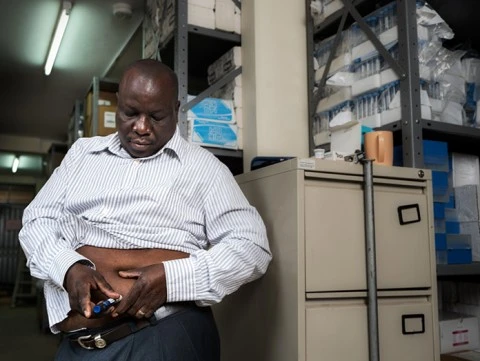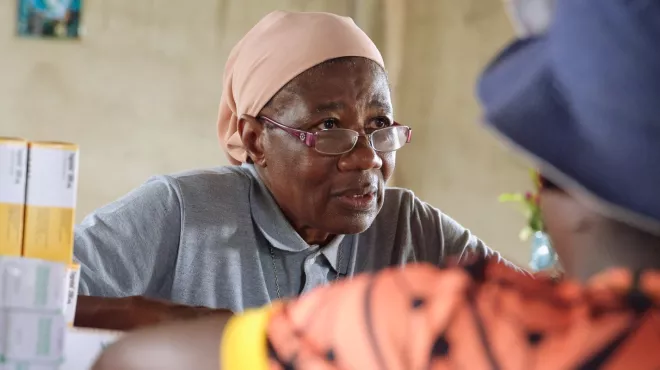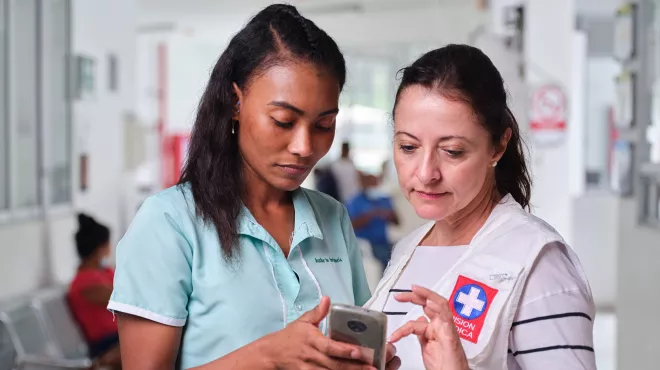A routine check may have saved Gian Cho De’s life. The 77 year old Vietnamese farmer trekked six miles to a community clinic for treatment of a minor ailment, but a standard test revealed dangerously high blood pressure and a significant risk of a heart attack or stroke.
Gian now benefits from regular check-ups and medical advice to help him improve his diet and lifestyle so he can control his blood pressure. His experience is increasingly common in this rural part of north-west Vietnam where healthcare workers are fighting a big increase in non-communicable disease.
“Hypertension, diabetes and cancer were once the preserve of wealthy countries, but we are seeing many new cases,” says Gian’s physician, Dr. Chang as Xinh.
The problem is not unique to Vietnam. Chronic diseases account for almost two-thirds of all deaths and some 80% of those deaths occur in low and middle-income countries, according to the World Health Organization (WHO).

As populations age and the number of elderly people worldwide grows, the challenge posed by chronic diseases will likely increase. By 2030, for instance, more people will die in the developing world from heart attacks and strokes than from infectious diseases, predicts the World Health Organization. Indeed, for countries still struggling to control infectious diseases such as malaria, tuberculosis and HIV/AIDS, the rise of chronic diseases represents a double burden.
“It’s a slow motion pandemic,” said Arnaud Bernaert, head of Global Health and Healthcare at the World Economic Forum (WEF). “Yet the problem is still flying below the radar in emerging economies because they have other, apparently more pressing problems.”
Beyond the physical and emotional challenges faced by sufferers of chronic diseases, there is also often a significant financial impact. People fighting illness may no longer be able to work and help support their families.
Chronic illnesses “cause billions of dollars of losses of national income and they push millions of people below the poverty line, each and every year,” WHO Director-General Dr Margaret Chan said at the launch of the organization’s Global Status Report on Non-Communicable Diseases.
Changing lifestyles and diets
Some of the causes behind the rise of non-communicable diseases stem from positive trends in society: better nutrition, improved hygiene and progress against communicable diseases mean people are living longer and therefore developing diseases of older age. Other reasons are less positive: rapid urbanization following economic growth often leads to changing diets and less active lifestyles.
At the same time, many people with chronic illnesses face difficulty gaining access to diagnosis and high-quality treatment and medicines. One obstacle to access is the lack of qualified doctors and nurses. Healthcare workers play a vital role in bringing basic care to patients at the community level, especially in rural areas, but many lack the knowledge to diagnose or treat complex diseases.
It's a slow motion pandemic. Yet the problem is still flying below the radar in emerging economies because they have other, apparently more pressing problems.
Arnaud Bernaert, head of Global Health and Healthcare at the World Economic Forum
Specialists are few and far between. Dr Helen Yifter Bitew, for example, is one of just six endocrinologists in Ethiopia, a country with a population of 94 million. She runs a specialist diabetes clinic at the Tikur Anbessa hospital in Addis Ababa. It is permanently busy.
“Many policymakers don’t see the full extent of the diabetes or hypertension problem,” she said. “It’s a hidden epidemic because these diseases are asymptomatic until the later stages when complications can be life threatening.”
Cultural factors also often play a role. In many countries, people still rely on traditional medicine as a first response to illness. Embarrassment and fear can keep people from seeking help. And chronic diseases may not be perceived as diseases until they become acute.
Cost is also a big factor, as a doctor’s visit means time off work. Long-term treatment, even when it’s available, is also expensive. A 2014 Economist Intelligence Unit report on non-communicable disease in sub-Saharan Africa found the cost of treating a chronic medical problem amounted to 29% of the average annual income.
“The majority cannot afford their treatment,” said Dr Kingsley Akinroye, a Nigerian cardiovascular health expert and vice-president of the World Heart Federation, in the EIU report.
Promising solutions

Some early efforts to address chronic disease are beginning to have an impact. Policies targeted at improving access to primary care are making progress. This includes training more community healthcare workers. Hundreds of thousands have fanned out into rural areas in Zambia, Kenya, Ethiopia and elsewhere.
In Rwanda alone, more than 45,000 trained health workers offer basic treatments and refer patients to doctors as part of a dramatic expansion of healthcare provision. The biggest gains in reducing deaths will likely come from prevention, by educating people about the importance of healthier lifestyles and eating habits. The government is campaigning about the risks of poor diet, physical inactivity, excessive alcohol and tobacco consumption.
This systematic approach works, Rwanda’s Minister of Health, Dr Agnes Binagwaho, a former pediatrician, said in the EIU report. “Our mission is to bring good health to all Rwandans. Having made great progress in combating communicable diseases, we now need to tackle non-communicable diseases.”
In Vietnam too, efforts at the community level extol the virtues of healthy living and better health awareness. Widespread monitoring includes identifying patients at risk of developing diabetes or hypertension and treatment for those with symptoms. Healthcare workers receive regular training. However, the challenge is to have more of them.
“Our biggest problem is to find the right people to be trained,” said Dr Cu Hong at the Mu Cang Chai clinic in Yen Bai province. “We face such a shortage of doctors here in this remote area, so to find a doctor to be trained in some specialist area is an even more difficult task.”
How far would you walk to see a doctor? For Gian Cho De, the 6-mile trek was critical. #NCDs #accesshealth



